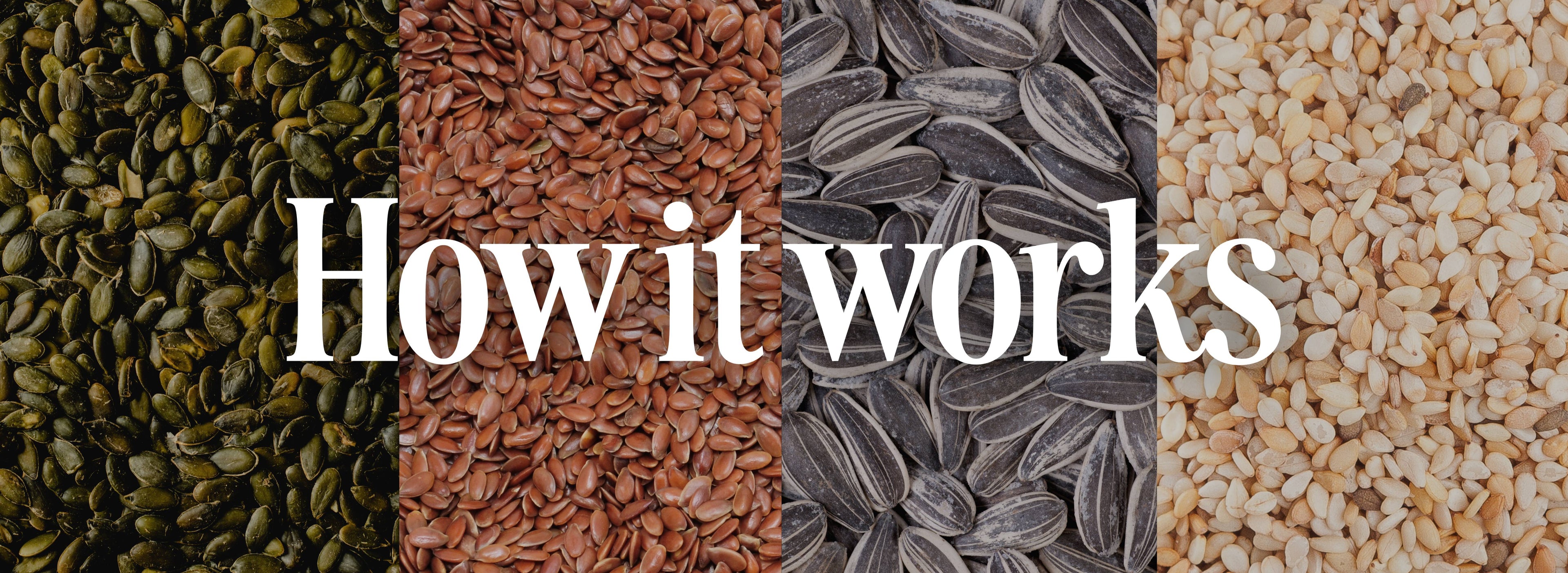
This page provides a basic explanation of how seed cycling works. For a more in depth, scientifically rigorous explanation, check out our page The Science.
What Is Seed Cycling?
Seed cycling is a gentle, food-based practice that supports your hormones using specific seeds during each phase of your menstrual cycle. Each seed is rich in nutrients that help your body naturally balance estrogen and progesterone — the hormones that govern everything from your skin and mood to energy, fertility, and period health.
The Seed Cycling Protocol
Your menstrual cycle is made up of two main phases:
The Follicular Phase -(~Day 1–14)
aka Phase 1
The Luteal Phase (~Day 15–28)
aka Phase 2
Each phase involves natural rises and falls in estrogen and progesterone — the two main hormones that influence everything from your energy and mood to skin, sleep, metabolism, and period symptoms. Seed cycling works by giving your body the right nutrients at the right time.
🌱 Phase 1: Flax + Pumpkin
- When: Day 1 (first day of period) to ovulation (~Day 14)
- Why: Support healthy estrogen levels in the first half of your cycle
- Helps with: PMS relief, Acne support, Estrogen balance, Energy + focus
🌻 Phase 2: Sesame + Sunflower
- When: Ovulation to the start of your next period (~Day 15–28)
- Why: Boost progesterone naturally in the second half
- Helps with: Bloating, Mood stability, Breast tenderness, Fertility support
How Seed Cycling Works: The Mechanics
Your body needs raw materials — specific vitamins, minerals, and compounds — to make hormones and keep them in balance. The seeds used in seed cycling provides these essential nutrients right when your body needs them.
Here’s what’s going on under the surface:
🌱 In Phase 1:
- Estrogen is rising to help your uterine lining build and to trigger ovulation
- Flaxseeds provide Omega-3s (regulate inflammation, support hormone synthesis, and improve mood), lignans (help your body process and clear excess estrogen to preventing estrogen dominant symptoms like acne, mood swings, and heavy periods)
- Pumpkin seeds provide zinc (a mineral essential for ovulation and sets the stage for progesterone production later in your cycle) and Magnesium (supports mood, reduces period pain, and calms the nervous system)
- Both seeds are rich in B vitamins (B1, B2, B3, B6, B9)which support energy, neurotransmitter balance, and estrogen metabolism
🌻 In Phase 2
- Your body needs to produce enough progesterone to balance estrogen, reduce PMS, and support fertility
- Sunflower seeds are rich in selenium (which help your ovaries produce progesterone), vitamin E (reduces inflammation and breast tenderness), and B6 (helps with mood stability and supports progesterone synthesis)
- Sesame seeds contain calcium (to ease cramps and emotional symptoms), iron (to prepare for iron loss that will occur during menstruation), and lignans, (for estrogen metabolism)
What else is happening
- Phytosterols in all four seeds gently modulate estrogen levels
- Protein + fiber in all the seeds stabilize blood sugar, which is key for hormone balance and reducing mood swings
- Liver support: Nutrients like lignans, selenium, and vitamin E support your liver’s ability to break down used hormones
- Gut health: The fiber in seeds feeds good gut bacteria, which help metabolize estrogen through the estrobolome
Go Deeper: The Science
Curious about the studies on seed cycling and the research on each of the seeds? Learn more about the science behind seed cycling here.
How To Start Seed Cycling
- Start taking Phase 1 (ground pumpkin & flax) on the first day of your period (or the new moon if your cycle is irregular)
- Switch to Phase 2 (ground sesame and sunflower seeds) after ovulation (~Day 15)
- Repeat the process, starting Phase 1 again after you finish Phase 2
We make it easy to get started with pre-ground, perfectly portioned bites and blends for each phase.
References
The American Journal of Clinical Nutrition, 79(2), 318–325. https://doi.org/10.1093/ajcn/79.2.318
Frontiers in Nutrition, 10, 1222584. https://www.frontiersin.org/articles/10.3389/fnut.2023.1222584/full
https://www.naturalcycles.com/cyclematters/what-is-seed-cycling
https://nourishedbynutrition.com/seed-cycling-for-hormone-balance/
https://timesofindia.indiatimes.com/life-style/food-news/the-right-time-to-consume-pumpkin-seeds-and-5-ways-to-include-them-in-daily-meals-in-a-tasty-way/photostory/122531890.cms
https://www.zepfcenter.org/news/2015/10/08/regular-news/health-corner-the-benefits-of-pumpkin-seeds
https://www.medicalnewstoday.com/articles/303864
Extension Journal, 7(7). https://www.extensionjournal.com/article/view/779/S-7-7-4
https://www.mariongluckclinic.com/blog/six-nutrients-boost-progesterone.html
https://www.rupahealth.com/post/a-guide-to-seed-cycling-for-hormonal-balance
https://bellehealth.co/increase-progesterone-in-pcos
Journal of Nutritional Biochemistry, 26(10), 1010–1021. https://doi.org/10.1016/j.jnutbio.2015.04.002
Molecular Nutrition & Food Research, 57(2), 267–276. https://doi.org/10.1002/mnfr.201200672
https://dutchtest.com/articles/can-seed-cycling-ease-menstrual-cycle-symptoms
Journal of Functional Foods, 92, 105024. https://www.mdpi.com/1661-3821/3/1/5